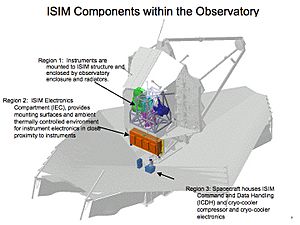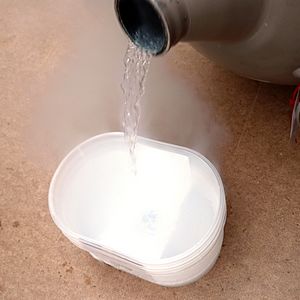Cryogenics facts for kids

Cryogenics is a field of physics that studies how to make and use extremely low temperatures. It also looks at how different materials behave when they are super cold.
Imagine temperatures much colder than your freezer! Cryogenics deals with temperatures so low that many gases turn into liquids. Scientists don't have one exact temperature where regular cooling ends and cryogenics begins. However, many agree it starts around −150 °C (123 K; −238 °F) or even colder.
For example, the U.S. National Institute of Standards and Technology says cryogenics involves temperatures below −180 °C (93 K; −292 °F). Gases like helium, hydrogen, neon, nitrogen, and oxygen all boil (turn into gas from liquid) at temperatures below −180 °C. This means they are liquids only at these very low temperatures.
Scientists who work with cryogenics often use special temperature scales. They use the Kelvin or Rankine scale. These scales start from absolute zero, which is the coldest possible temperature in the universe. This is different from the Celsius or Fahrenheit scales, which we use every day.
Contents
What Are Cryogenic Temperatures Used For?
Cryogenic temperatures are super useful in many areas of science and technology.
Medical Uses of Cryogenics
- Medical Imaging: Magnetic resonance imaging (MRI) machines are very important tools in hospitals. They use powerful magnets cooled by cryogenic liquids to create detailed pictures of the inside of your body. This helps doctors see soft tissues and diagnose problems.
- Studying Atoms: Nuclear magnetic resonance (NMR) is a technique used to study the physical and chemical properties of atoms. It also relies on very low temperatures to work correctly.
Cryogenics in Space and Industry
- Rocket Fuel: Some rockets use cryogenic fuels. These are gases like liquid hydrogen and liquid oxygen. They are stored at extremely low temperatures and provide a powerful push for rockets to launch into space.
- Food Preservation: Cryogenics helps store and transport large amounts of food. By freezing food very quickly at super-low temperatures, it stays fresh for much longer without spoiling.
- Scientific Experiments: Many advanced physics experiments need very cold conditions. Cryogenic temperatures help scientists study materials and their properties in unique ways.
- Efficient Power: Cooling underground electricity cables to cryogenic temperatures makes them much more efficient. This means less energy is lost as heat when electricity travels through them.
Images for kids
-
Astronomical instruments on the Very Large Telescope use continuous cooling systems.
-
A truck delivering cryogenic gases to a supermarket in Ypsilanti, Michigan.
See also
 In Spanish: Criogenia para niños
In Spanish: Criogenia para niños




